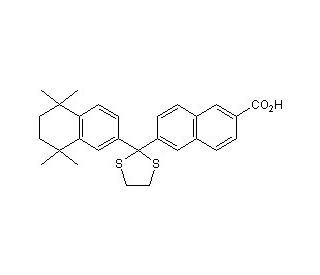

MM 11253 の分子構造、CAS番号: 345952-44-5
MM 11253 (CAS 345952-44-5)
参考文献をチェックします (2)
別名:
6-[2-(5,5,8,8-Tetramethyl-5,6,7,8-tetrahydro-2-naphthalenyl)-1,3-dithiolan-2-yl]-2-naphthoic acid
アプリケーション:
MM 11253は選択的RARγアンタゴニストである
CAS 番号:
345952-44-5
分子量:
462.67
分子式:
C28H30O2S2
試験・研究用以外には使用しないでください。 臨床及び体外診断には使用できません。
* Refer to Certificate of Analysis for lot specific data.
クイックリンク
注文情報
参考文献
説明
技術サポート情報
安全情報
SDSと分析証明書
MM11253は選択的RARγ拮抗薬である。MM11253は,扁平上皮癌 (SCC) -25細胞におけるRARγ選択的アゴニストの増殖阻害能を阻害することも示されている。MM‐11253はレチノイン酸受容体γ (RARγ) に対する選択的アンタゴニストとして機能する独特の立体配座を有する合成レチノイドである。全トランス型レチノイン酸の活性に影響を与えることなく、RARγ選択的アゴニストによって誘導される増殖阻害作用を効果的に打ち消す。この性質はMM‐11253を扁平上皮癌 (SCC) -25細胞における抗アポトーシス剤とし, RARγ選択的アゴニストにより誘発される増殖阻害を阻害する選択的RARγアンタゴニストとして機能する。
MM 11253 (CAS 345952-44-5) 参考文献
- レチノイン酸受容体機能の調節により, 口腔SCC細胞のレチノイドに対する増殖抑制反応が変化する。 | Le, Q., et al. 2000. Oncogene. 19: 1457-65. PMID: 10723137
- AHPN/CD437による卵巣癌細胞のアポトーシス誘導は, レチノイン酸受容体を介する。 | Holmes, WF., et al. 2000. J Cell Physiol. 185: 61-7. PMID: 10942519
- レチノイン酸受容体γ機能の遺伝的および薬理学的阻害は軟骨内骨形成を促進する。 | Uchibe, K., et al. 2017. J Orthop Res. 35: 1096-1105. PMID: 27325507
- アルツハイマー病におけるAβ42凝集の特定の微視的段階を阻害する低分子の系統的開発。 | Habchi, J., et al. 2017. Proc Natl Acad Sci U S A. 114: E200-E208. PMID: 28011763
- レチノイン酸はゼブラフィッシュ成体における神経堤由来の眼球および頭蓋顔面構造の機能を維持する。 | Chawla, B., et al. 2018. Invest Ophthalmol Vis Sci. 59: 1924-1935. PMID: 29677354
- オールトランス型レチノイン酸は, ヘテロ二量体型骨形成タンパク質2/7刺激による破骨細胞新生と吸収活性を阻害する。 | Bi, W., et al. 2018. Cell Biosci. 8: 48. PMID: 30159139
- 放射線と宿主レチノイン酸シグナルは同種造血幹細胞移植後の腸管ホーミングドナーT細胞の誘導を促進する。 | Zheng, J., et al. 2020. Am J Transplant. 20: 64-74. PMID: 31207088
- オールトランス型レチノイン酸とヒト唾液中ヒスタチン-1はin vitroで前骨芽細胞の増殖と骨形成活性を促進する。 | Sun, W., et al. 2020. FEBS Open Bio. 10: 396-406. PMID: 31957262
- レチノイン酸受容体αのアンタゴニストであるER-50891は, オールトランス型レチノイン酸の抑制効果に拮抗し, 骨形成タンパク質2誘導性骨芽細胞分化を回復させる。 | Wang, S., et al. 2020. Drug Des Devel Ther. 14: 297-308. PMID: 32158187
- レチノイン酸とリンパ毒素シグナルはヒト腸管M細胞の分化を促進する。 | Ding, S., et al. 2020. Gastroenterology. 159: 214-226.e1. PMID: 32247021
- レチノイン酸受容体γの活性化は, ヒト人工多能性幹細胞の食道上皮への分化を促進する。 | Koterazawa, Y., et al. 2020. J Gastroenterol. 55: 763-774. PMID: 32556644
- 嗅覚受容体OR7A17の発現は, 全トランス型レチノイン酸(ATRA)によるヒトケラチノサイト細胞の増殖抑制と相関する。 | Kim, H., et al. 2021. Int J Mol Sci. 22: PMID: 34830183
- 合成レチノイドは, RARγ-トランスロケーションを介した緊張緩和とクロマチン脱凝縮を誘導することにより, 薬剤耐性がん幹細胞を死滅させる。 | Zhang, Y., et al. 2022. Adv Sci (Weinh). 9: e2203173. PMID: 36031407
- RARγを介したレチノイン酸シグナル伝達の遮断は, G1-S期の細胞周期進行を停止させることにより, 膵臓がん細胞の増殖を抑制した。 | Yamakawa, K., et al. 2023. Cancer Cell Int. 23: 94. PMID: 37198667
の阻害剤である:
1300002K09Rik, GREB1L, RAR gamma, RXRβ, RXRβ2.のアクティベーター:
RAR beta, RORβ.注文情報
| 製品名 | カタログ # | 単位 | 価格 | 数量 | お気に入り | |
MM 11253, 10 mg | sc-361255 | 10 mg | $468.00 | |||
MM 11253, 50 mg | sc-361255A | 50 mg | $2000.00 |
